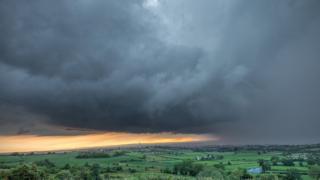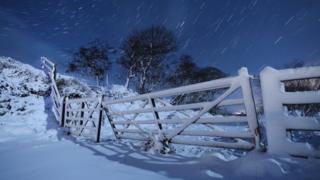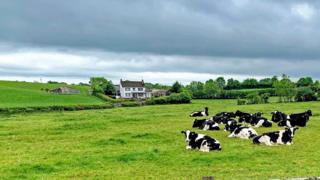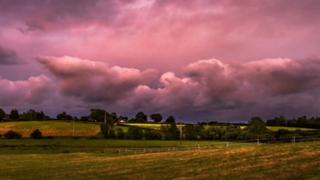NI weather: The stories behind our popular weather sayings
 Image copyright
Image copyright
Alan Hops
Does science support some of our most popular sayings about the weather?
Most of us have been enjoying the outdoors recently and the long evenings at this time of year are very welcome.
We’ve had some stunning sunsets with oranges, pinks and reds flooding the dusk sky.
A lot of us are familiar with the weather adage: “Red sky at night, sailor’s/shepherd’s delight. Red sky in the morning, sailor/shepherd take warning.”
But just how true is that saying?

‘Red sky at night’
When the western sky is especially clear, there is often a red sunset.
That’s because as the sun sets, its light shines through much more of the lower atmosphere, which contains dust, salt, smoke and pollution.
These particles scatter away some of the shorter wavelengths of light (the violets and blues), leaving only the longer wavelengths (the oranges and reds).
 Image copyright
Image copyright
Christopher McKay
If an area of high air pressure is present, the air sinks.
This sinking air holds contaminants near the earth, making the sunset even redder than usual. This would be the “red sky at night”.
Weather systems most often approach us from the west.
Since high pressure generally brings fair weather, this type of red sky at sunset would indicate that clear weather is approaching, which would “delight” a sailor or shepherd.
If the sky is red in the eastern morning sky for the same reasons as above, then the high pressure region has most likely already passed through, and an area of low pressure may follow.
Low pressure usually brings clouds, rain or storms, a warning for sailors and the rest of us.

‘Mare’s tails and mackerel scales’
People have been forecasting the weather for centuries.
They once looked to plants and animals for hints about what the weather would do.
For example, before it rained, some people often observed that cows lay down, pine cones opened up, frogs croaked more frequently and sheeps’ wool uncurled
 Image copyright
Image copyright
Joseph Cullen
Over the years, people began to notice other natural clues to upcoming weather and several sayings emerged.
Some proverbs arose simply from coincidence, not weather patterns, and are just old wives tales – but under certain circumstances, some do hold up to science.
For instance “mare’s tails and mackerel scales make tall ships take in their sails”.
A mackerel sky refers to cirrocumulus clouds, which often precede an approaching warm front.
This will eventually bring veering winds (changing from east or southeast over to southwest and west) with rain.
Sailors therefore need to adjust their sails.

‘Clear moon, frost soon’
If the atmosphere is clear, the surface of the earth will cool rapidly as heat is radiated away at night.
There is no blanket of clouds to keep the heat that the ground absorbed during the day from radiating (disappearing) back up into space.
If the temperature is low enough on these clear nights and there’s no wind, frost may form.

‘When the stars begin to huddle, the earth will soon become a puddle’
When clouds increase, whole areas of stars may be hidden by clouds and groups of stars that are still visible appear to huddle together.
The clouds are increasing, so the chance of rain is increasing too.

 Image copyright
Image copyright
Martin McKenna
‘Too cold to snow’
The colder the air gets (for example -20C) the less water vapour it can hold, so reducing the likelihood of snow.
There are many other factors to consider when it comes to whether or not it will snow and it’s unlikely we would experience temperatures this low on these islands.
So this is true – but unlikely to happen here.

 Image copyright
Image copyright
Ian
‘Cows lie down when it is about to rain’
There’s no scientific backing for this at all.
Cows spend up to half their time lying down, either to rest or to chew their cud, so there’s a 50:50 chance they’ll be lying down at any given moment, come rain or shine.
As herd animals, cows tend to mimic each other’s behaviour, upping the odds that you might see a whole herd lying down before a downpour.

‘Pine cones open up when good weather is coming’
In dry weather, pine cones dry out, which causes their scales to stand out more stiffly, giving an ‘open’ appearance.
In damp conditions, they become more flexible and return to a more closed shape.

 Image copyright
Image copyright
Tommy Ashe
‘Animals and thunder’
Cats and dogs are more sensitive than humans to sounds, smells and changes in atmospheric pressure and their heightened senses can allow them to pick up hints that a storm is coming well before their owners catch wind of it.
Just before a storm, your cat’s inner ears may detect the sudden fall in atmospheric pressure and it may have learned to associate this with an impending storm.
If a storm is already raging in the distance, it may be able to perceive the faint rumble of thunder.
Likewise, your dog may be able to smell incoming rain, or the characteristic whiff of ozone gas, which is often created by lightning and has a sharp, metallic odour.

‘Arthritis and weather changes’
Cold and damp weather affects those living with arthritis, as this type of climate can create increased joint pain.
Many arthritis sufferers claim they can predict rainfall due to the level of pain in their joints.
The change in atmospheric pressure as a weather system approaches brings more pressure to joints, as well as weak bones or even teeth.
On the other hand, warm, dry climates with a relatively stable high pressure area may ease the stress on joints.
This means that people with arthritis in warmer places may have less pain than those who live with dramatic, cold and wet weather.

 Image copyright
Image copyright
Barrie Buckley
‘Thunder and headaches’
If you’re prone to getting headaches, you could find that grey skies, high humidity, rising temperatures and storms can all bring on head pain.
Pressure changes that cause weather changes are thought to trigger chemical and electrical changes in the brain. This irritates nerves, leading to a headache.
This is why it is always important to stay up to date with the BBC NI weather team.
.
from WordPress https://ift.tt/3hHqTpD



No comments